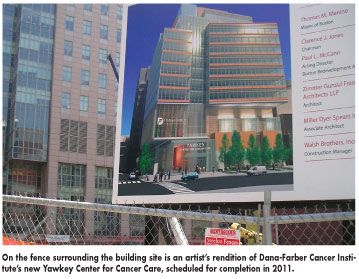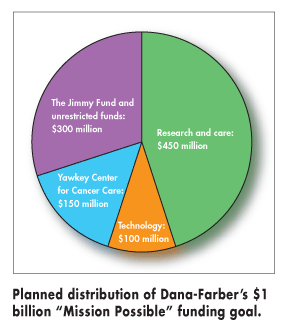Dana-Farber over half way to $1 billion funding goal
There's a huge hole in the ground in the shadow of the Dana-Farber Cancer Institute, but within 4 years, a gleaming 13-story facility—the Yawkey Center for Cancer Care—will rise on the corner of Brookline Avenue and Jimmy Fund Way, creating a new "front entrance" to the Institute and expanded cancer care opportunities for the thousands of patients who will walk through it each year.
BOSTONThere's a huge hole in the ground in the shadow of the Dana-Farber Cancer Institute, but within 4 years, a gleaming 13-story facilitythe Yawkey Center for Cancer Carewill rise on the corner of Brookline Avenue and Jimmy Fund Way, creating a new "front entrance" to the Institute and expanded cancer care opportunities for the thousands of patients who will walk through it each year.

Constructed on Dana-Farber's last remaining parcel of land (see photo), the Yawkey Center for Cancer Care is a vital component in the Institute's goal of making Dana-Farber the "model cancer center" for patient care, basic science, and the research that bridges them.

As part of a bold strategic plan called Mission Possible: The Dana-Farber Campaign to Conquer Cancer, the Institute seeks to raise a $1 billion capital investment in four critical areas (see Figure): research and care, technology, the Yawkey Center, and the Jimmy Fund, named for a young cancer patient of Dr. Farber who was introduced to the nation in a 1948 fundraising radio broadcast of the show "Truth or Consequences."
Mission Possible holds with the vision of the Institute's founder, Sidney Farber, MD, a doctor of indefatigable drive, who, in 1947, became known as the "father of chemotherapy," after achieving the first clinical remission ever reported in childhood leukemia.
A tall, stately man, Dr. Farber was, in many respects, ahead of his time, coming up with the then novel concept of "total care," in which all patient care and family services are delivered compassionately in one facility. Today, the institute that bears his name embraces that standard, delivering comprehensive care in more than 150,000 patient-visits a year.
Edward J. Benz, Jr., MD, Dana-Farber's president and CEO, told ONI that Dana-Farber distinguishes itself from other cancer centers in two important ways. "First, we commit at least 50% of our effort, resources, space, and fundraising to research," he said. "And second, everyone here is committed to the mandate that each patient must feel that he or she is special to us, and will get the very best in high-tech and high-touch care."
Dr. Farber was reluctant to forecast a date when cancer would be cured. He contended that building a solid basis of accomplishment in research would permit a "controlled optimism and expectation of rapid progress." The people at Dana-Farber believe they have reached a turning point in the battle against cancer. The relentless spirit behind the Mission Possible campaign is proof of that.